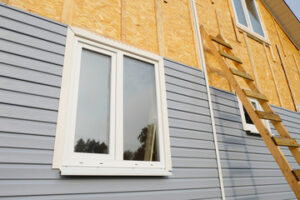How to Fix Vinyl Siding Repair
Vinyl siding is tough and durable but can be damaged by rain or insects. Holes, cracks, and other damage are easy to fix with caulk and replacement panels that match your home’s existing color.
Before starting, gather the proper tools and materials for the repair. These include a utility knife, a vinyl siding zip tool, and caulk. Contact Vinyl Siding Repair Charleston SC for professional help.
A cracked piece of vinyl siding may be the first sign that it’s time for repairs. These cracks can leave your home exposed to moisture, bugs and other natural elements that can cause significant damage to your house over time. These cracks should be repaired immediately to avoid further damage to the siding and your home.
It’s important to inspect the vinyl siding on your home regularly, especially after severe weather events or when you notice a change in appearance. This will help you catch problems early so that they don’t worsen over time. In addition, if you are noticing cracks in your vinyl siding, this can be a warning that the structure of the siding is beginning to wear out and needs to be replaced.
Cracks in vinyl can happen from exposure to extreme temperature changes, but they can also occur over the course of years. In order to properly repair vinyl, it is important to work with a professional who understands the material and can install it correctly.
The best way to prevent this from happening is by installing vinyl siding that has been formulated to resist the effects of weather and other environmental factors. You should also make sure to use a quality installation method and seal the cracks with caulk.
You can fix minor holes in your vinyl siding by using a fiberglass patch kit. Follow the instructions included in the kit to ensure that you get a solid and lasting repair. It’s important to find a patch kit that matches your siding color to ensure that the repair is unnoticeable.
Alternatively, you can use a putty to fill the hole or crack. Using a plastic putty knife (as opposed to metal, which can damage the vinyl) apply the filler to the hole and spread it evenly over the area. Let the filler dry before applying a second coat, which you should also smooth with your putty knife.
If you are experiencing holes in your vinyl siding that are larger than 1 inch in size, it will be difficult to make a clean and seamless repair with tape or caulk alone. You can purchase self-adhesive vinyl patch kits that include both a lower and upper surface layer to provide you with a more durable, long-lasting and customizable solution. Follow the directions for preparing the patch and painting to ensure that you achieve an even finish and color match.
Dents
Vinyl siding isn’t immune to dents and chips caused by hail, rocks, or even everyday wear and tear. Over time, a few of these dents can make your home look unsightly and less appealing. If you notice any dents in your vinyl, it’s important to address them quickly to maintain the integrity of your home.
For smaller dents and holes, you can likely complete this project without needing the assistance of a professional. First, clean the working area to provide a smooth surface that caulk can adhere to. Next, use a zip tool to disconnect the damaged panel from those above and below it. Insert the curved tip of the tool blade under the end of the overlapping panel and hook it onto the back lip of the panel’s bottom edge (buttlock). Pull downward to separate the panel.
Once you’ve disconnected the panel, remove any nails or screws from the back of the piece. Next, fill the hole with auto-body putty or a similar product and sand it smooth afterward. Once the repair is dry, apply a coat of matching exterior paint to help it blend in with the surrounding vinyl.
The longer you go with a chip, crack, or hole in your vinyl siding, the more susceptible it is to insect infestations. Putting off this project will only lead to costly exterminator fees, so it’s important to act quickly once you notice a problem.
For larger holes and cracks, you’ll need to replace the piece of vinyl that’s damaged. Fortunately, many homeowners will have leftover pieces of vinyl from the last time their house was sided. Depending on where you live, you may be able to find leftover pieces tucked away in storage by the previous homeowner or on a shelf in the garage. If not, you can buy replacement pieces of vinyl at a hardware store or online. To prepare a replacement piece of vinyl, you’ll need to cut it down to size so it fits snugly over the hole or crack. Carefully measure the gap to ensure your patch will be a perfect fit before cutting.
Holes
Holes in vinyl siding can be a serious problem that allows moisture, pests, and other problems to damage your home. They also affect the overall appearance of your house and may make it look less attractive than you’d like. If you’re a homeowner with holes in your vinyl siding, there are some simple steps that can help you fix it and restore the appearance of your home.
A small hole can often be repaired with a bit of color-matched caulk. Before applying the caulk, be sure to clean the area thoroughly to ensure that you’re working on a smooth surface that will adhere well. Once the caulk has dried, be sure to paint it to match your siding so that it blends in perfectly.
If you have a larger hole, it’s usually best to replace the damaged section of vinyl siding. This will provide a stronger and more attractive repair. However, before replacing the vinyl, it’s important to make sure that you’re able to access the nails or screws that hold the panel in place. If you’re unable to access the nails, then you will need to use a hammer or pry bar to break the panel free from the rest of your vinyl.
Before removing the old vinyl, you will want to de-gloss the area by wiping it down with warm soapy water and a microfiber cloth. Once the surface is clean, you can then cut a spare piece of vinyl to the size of the hole.
Using a zip tool, unlock the section of vinyl above the damaged panel by inserting the curved tip of the tool under the end of the overlapping panel and hooking onto the back lip of the vinyl section at the bottom of the panel (buttlock). Begin to unzip the panel from one side and work your way toward the other end, disconnecting it from its neighbors along the way.
When you’re finished, remove the panel from your home and set it aside. Using the same method that you used to de-gloss and clean the surface, apply foil tape to the back of the replacement panel. After that, attach the patch to the sheathing of your home using DAP Dynagrip Heavy Duty MAX Construction Adhesive. After the adhesive has dried, be sure to paint the patch to match your siding.
Stains
Vinyl siding has a reputation for bold colors that will last a long time, but the reality is it can stain. Various causes of discoloration, from mildew to algae to mold growth, can affect the appearance of your vinyl home. A thorough cleaning and a few preventative measures should keep your vinyl siding looking great for years to come.
Most stains can be removed from vinyl with normal household cleaners, though you may need a stronger chemical to treat the problem. The type of stain will determine what kind of cleaner is needed to remove it. For example, pencil, crayon and paint stains can be cleaned with most cleaners, but stains from oil or grease may require a stronger solution like liquid grease remover or chlorine bleach. You should avoid using any cleaners that contain organic solvents or abrasives, as these will negatively affect the surface of your vinyl.
In addition to a thorough cleaning, you can use a vinyl restorer to revitalize your siding and give it a new look. A vinyl restorer is a liquid product that is applied to the surface of your vinyl, and it will return the color to the original luster while also sealing and protecting the siding. To apply a vinyl restorer, you should first clean the siding with a detergent and water. Be sure that the weather is clear and there are no chances of rain for 24 hours before you apply a second coat of the restorer.
Stains and discolorations on vinyl are inevitable, especially in areas where the building is exposed to extreme sunlight or climate conditions. Whether it’s dirt, chalk accumulation, algae or mildew, these stains will eventually degrade the look of your vinyl siding. Keeping up with regular cleaning and maintenance will help prevent these problems and extend the life of your vinyl siding.
While the lifespan of vinyl siding varies considerably by climate, proper installation and maintenance will help it last between 20 to 40 years. Proper handling and upkeep will ensure that your vinyl is beautiful and functional for as long as possible, enhancing your home’s curb appeal and increasing its value.

